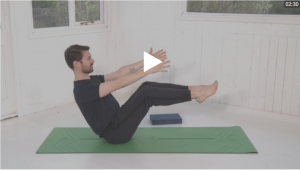Have you ever wondered what stops you moving further in a particular pose or why a pose feels completely different from one day to the next?
Or why one person can sit cross-legged for hours having never practiced yoga and you still need to sit on four cushions after practicing yoga for years?
We asked Dr Yogi!
The short answer to this is that every body is physically unique and we will therefore express each yoga pose in a completely unique way. There are also emotional, psychological and nervous system components that affect how we move and how much movement our joints make.
Lets explore the physical limitations further using a simple forward fold as an example:
1. Tension
There is a joint capsule and ligaments surrounding your hips joints that are there to support the joint and prevent dislocation. These structures hold tension and will limit your range of movement in different ways depending on various factors. Muscles, tendons and fascia also surround the joint and their suppleness will vary greatly person to person.
There are many reasons why a muscle can become tense; as a result of overuse of a particular muscle group, following injury in order to prevent further injury and support healing, underuse or weakness of a muscle group leading to tension via the nervous system as a way to stabilise the area, because of compensation due to a related muscle not working effectively.
If you are experiencing tension in a forward fold you will most likely feel this behind the direction of the movement ie along the back of your body.
2. Compression
The boney structure of the femur (thigh bone) varies immensely from person to person and may have a huge impact on the range of movement of the hip joint.
The femur has a neck that lies between the head and the shaft of the bone and the angle of the neck can range from 110° to 150° in most people. The position of the head in relation to the neck and shaft will vary person to person. The head can be tilted slightly forward, back, up or down resulting in an infinite number of possible variations.
The boney structure of the hip socket (acetabulum) also varies immensely from person to person. While one yoga student has a shallow hip socket the student practising next to them may have a deeper socket. This will potentially have a huge impact the range of movement of the hip in all directions. Some people have a hip socket that is positioned slightly further forward or further back, angled upwards or downwards. Again there are an infinite number of possibilities here!
No one has a right hip joint that is architecturally the same as their left hip joint. This means that your right hip joint will move in a unique way and have a unique range of movement compared to the left. While doing an assymetrical forward fold easily on the right you might find the left side really challenging.
Subcutaneous fat, blood vessels, nerves and organs can also often get in the way when we are moving our hip joints in different directions. Sometimes we can move around these obstacles but often compressive forces cannot be bypassed and need to be humbly accepted.
If you are experiencing compression in a forward fold you will most likely feel this in the direction of the movement ie at the front of your body.
3. Nervous System
Our nervous system governs all of our voluntary and involuntary movements and is constantly monitoring the state of our body in order to keep it safe. It recognises “normal” movements that we make throughout our day and considers these safe. But when we move into ranges of movement that are less familiar it is less likely to facilitate these and may even create a sensation of discomfort in order to limit us. The most effective way to work with our nervous system is to remain mindful of the movements that we make, make the movements as controlled as possible and stay connected with our breath. Remember that the nervous system can also limit our movement by creating tension in muscles that are weak or injured.
Try Yoga with Dr Yogi!
>>Check out Dr Yogi’s range of yoga classes on Movement For Modern Life>>
 This post was written by Andrew McGonigle, aka Dr Yogi, a yoga and anatomy teacher with a background in western medicine. Andrew has been practising yoga and meditation for 13 years and teaching since 2009. Andrew’s classes are open to all levels and encourage students to develop awareness of patterns of tension in their bodies with a goal to release stress. Andrew teaches anatomy and physiology on many different Yoga Teacher Training courses in London and internationally. Find Doctor Yogi on Facebook.
This post was written by Andrew McGonigle, aka Dr Yogi, a yoga and anatomy teacher with a background in western medicine. Andrew has been practising yoga and meditation for 13 years and teaching since 2009. Andrew’s classes are open to all levels and encourage students to develop awareness of patterns of tension in their bodies with a goal to release stress. Andrew teaches anatomy and physiology on many different Yoga Teacher Training courses in London and internationally. Find Doctor Yogi on Facebook.







Leave a Reply